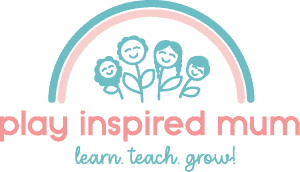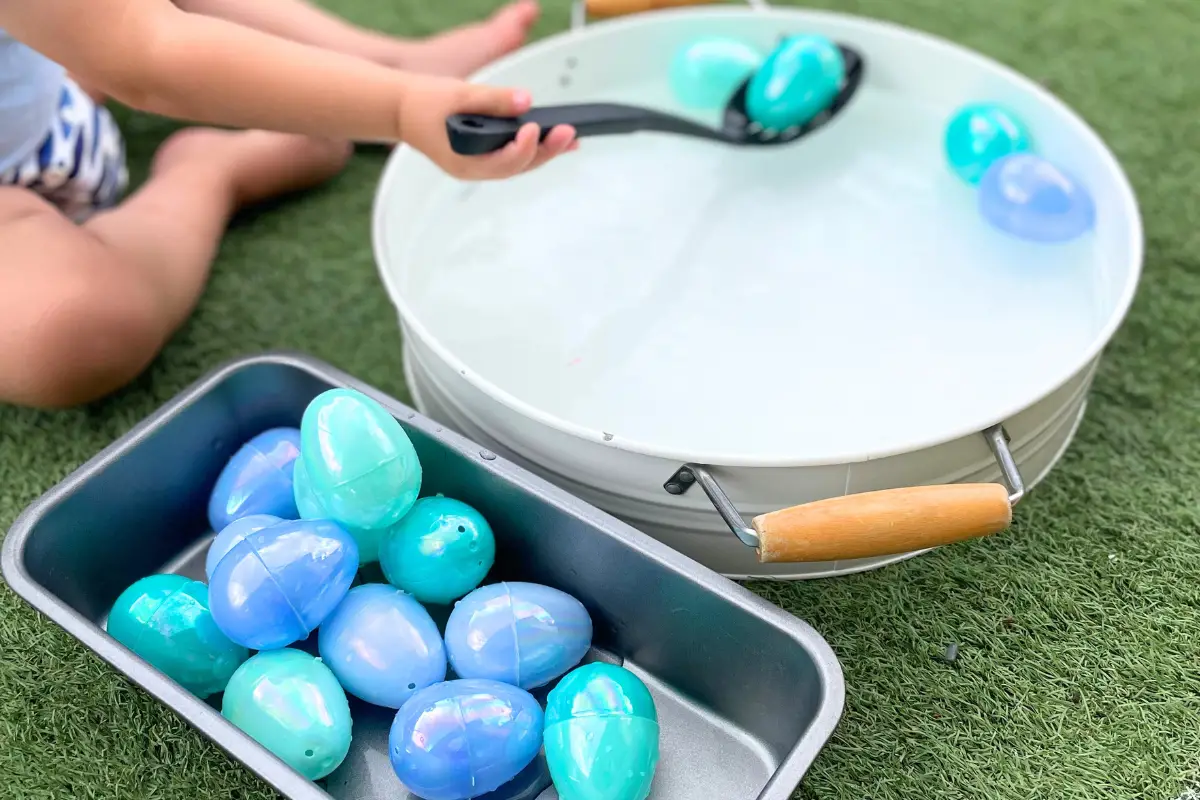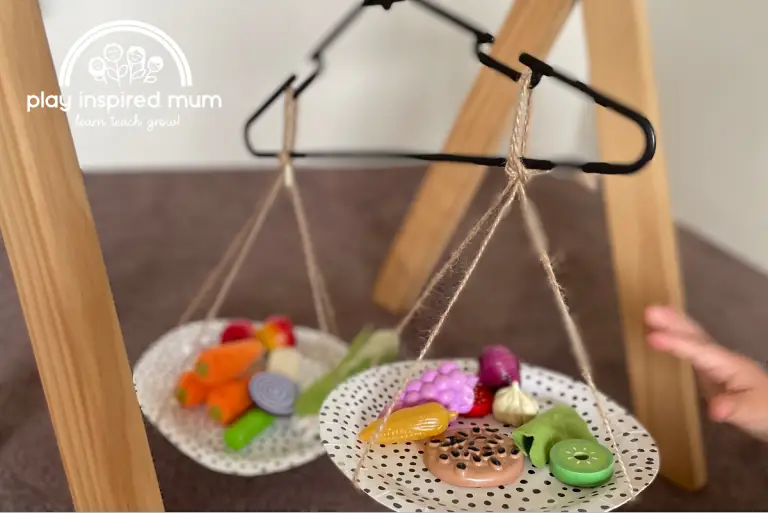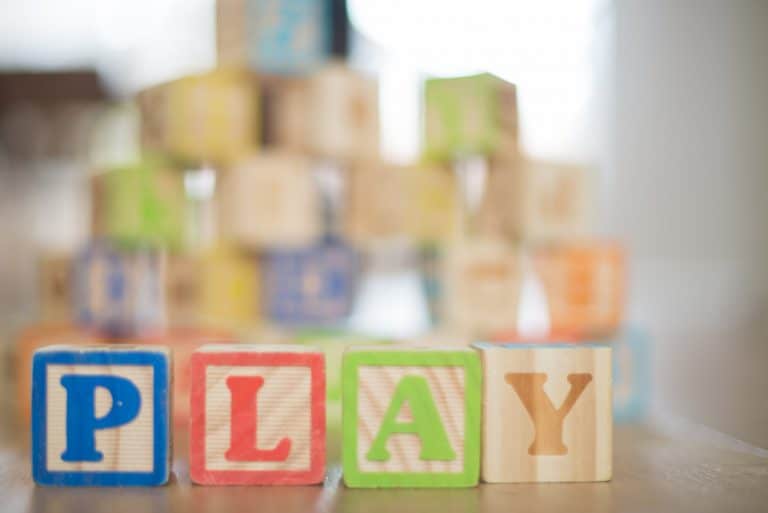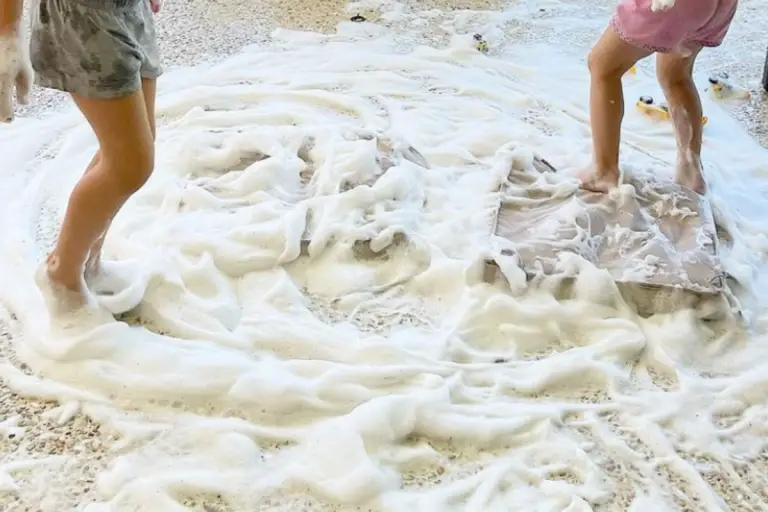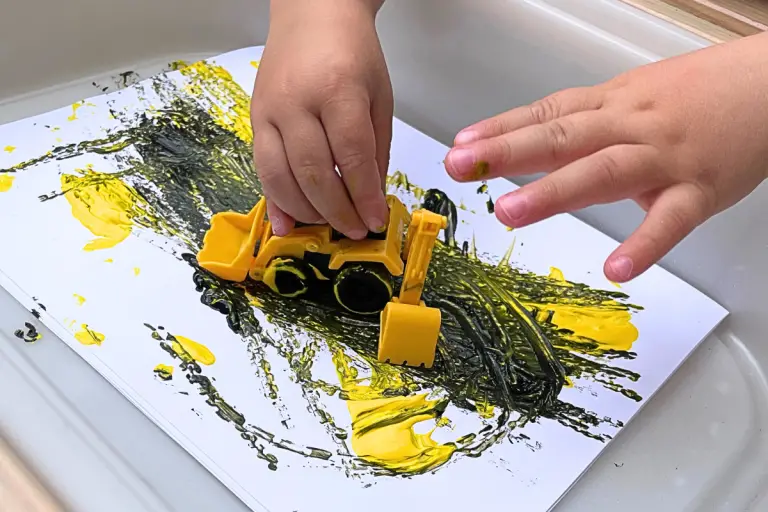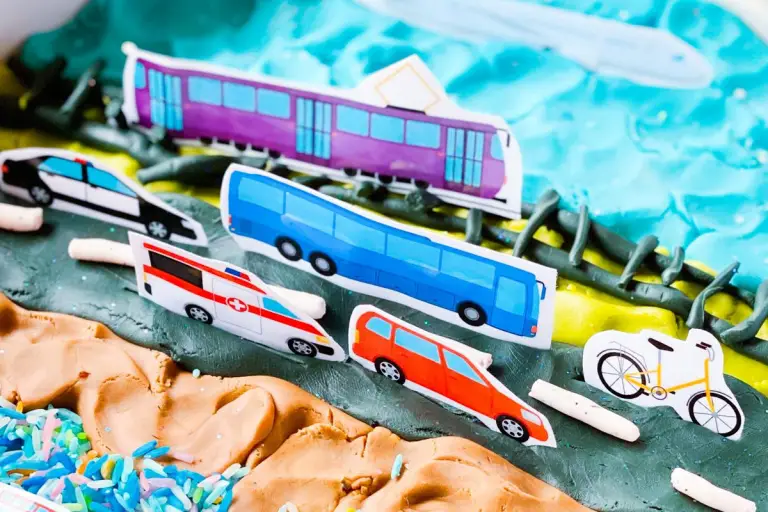Egg-citing Scoop & Transfer: Water Play Fun for Toddlers
Disclosure: This blog contains affiliate links which I may earn a small commission from if you purchase through them, at no extra cost to you.
Reuse those plastic eggs left over from easter to cream this scoop and transfer egg water play activity for your toddler.
Plastic fillable eggs are brilliant for play all year round.
Teamed up with some kitchen essentials, and a bit of water and you can have this seemingly simple activity set up in minutes.
I say seemingly simple because well…. it is super simple to set up however the developmental learning it inspires is absolutely not merely simple.
Your kid will be exposed to learning opportunities that will allow them to practice and refine skills that they will carry well into their adulthood.
Not bad for some plastic eggs and a tray of water is it?
This scoop and transfer activity is exactly what we mean when we say meaningful play’ and ‘learning through play’.
Enough jibber jabber, here is how we repurpose classic plastic Easter eggs to create a fun learning activity for toddlers.
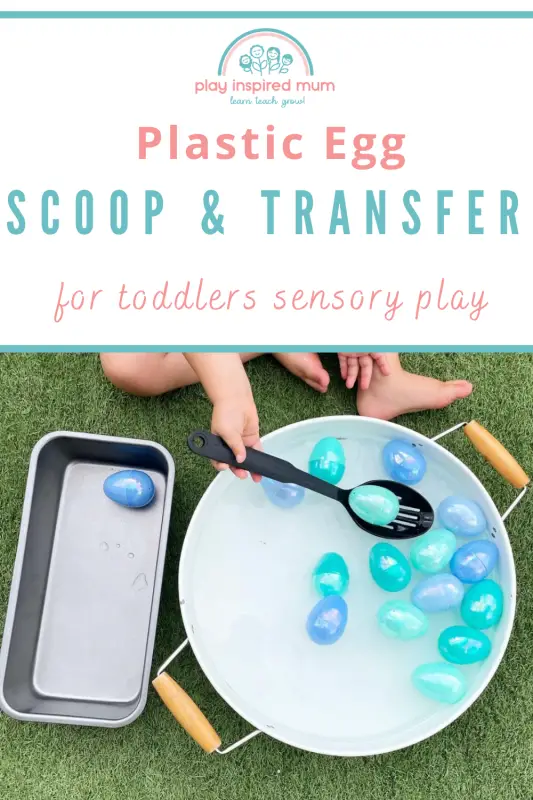
Scoop and Transfer Water Play
I had stumbled upon an engaging way to introduce my toddler to sensory play while also fine-tuning their fine motor skills.
It involved nothing more than some plastic Easter eggs, a variety of containers, and water.
This scoop and transfer game was not just about having fun
It became an undercover mission for learning through play.
My little one became engrossed in the simple task of using a slotted spoon to move the eggs from one place to another.
This activity was a treasure trove for developmental milestones.
Not only did it boost hand-eye coordination by challenging them to successfully transfer eggs without dropping, but it also encouraged them to explore the sensory-rich world of water play.
As the eggs filled with water and splashed down into their new homes, laughter filled the air.
This was meaningful play in its purest form.

Why Water Play?
Imagine the joy on a toddler’s face as they discover the cool touch of water or listen to the delightful sounds of splashing.
Within those moments, a world of learning unfolds.
Engaging young minds in water play is not just about fun.
It serves as a critical platform for sensory development and the mastering of fine motor skills.
Babies and toddlers, through simple activities like scooping and transferring using plastic eggs with slotted spoons, embark on a fascinating journey of discovery.
Each scoopful of water and each transfer from one place to another is a lesson in cause and effect.
As they maneuver a scoop through water, toddlers refine their hand-eye coordination, laying the foundation for more complex tasks in the future.
This kind of sensory play, especially when it involves water play, fosters an environment where learning through play becomes deeply impactful.
It allows them to cross the midline, a vital developmental skill, in a natural and engaging way.
Beyond the tactile exploration, water play stirs curiosity about the natural world, making every splash and spill a meaningful play experience.
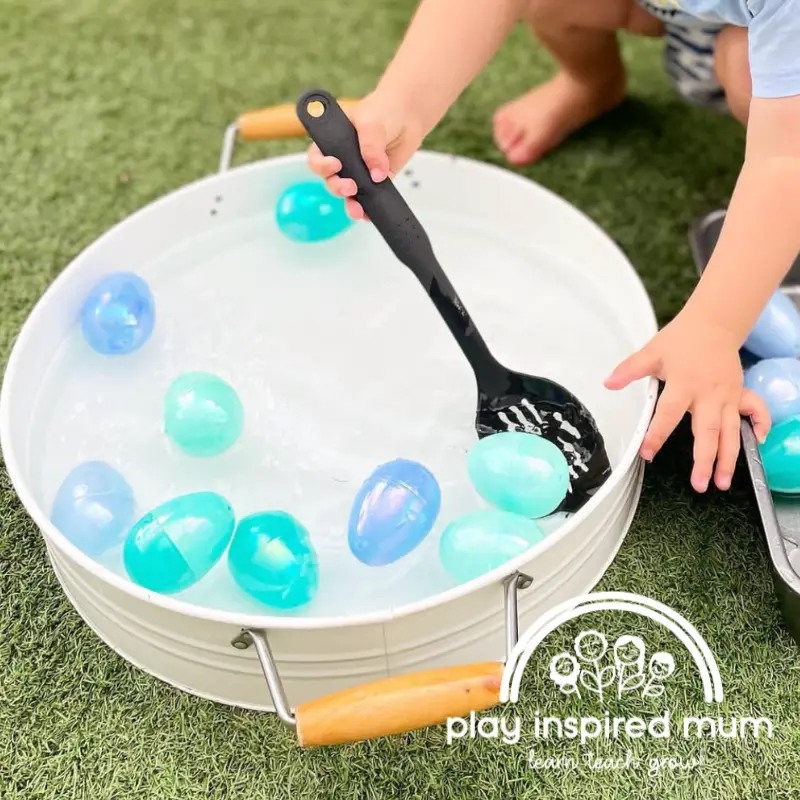
What You’ll Need
Gathering the materials for our egg-citing scoop and transfer activity will be a breeze.
Plastic eggs, known for their versatility, will be the stars of our show.
I’ve always found these colourful plastic Easter eggs not only appealing but perfect for tiny hands.
A variety of scoopers will add to the fun.
Think slotted spoons and anything else that can help in transferring water.
Of course, the essence of water play is, well, water.
We will need plenty of it!
Next, secure some plastic containers.
They will hold our water and eggs, creating an arena for sensory exploration.
This setup promises a delightful sensory play experience for toddlers and babies alike.
Engaging in this scoop and transfer adventure, they’ll navigate through learning through play.
With every scoop your child will be enhancing hand-eye coordination and encouraging the delightful mess that is meaningful play.
Setting Up Your Play Area
I had to think creatively to ensure our play area was both engaging and mess-free for the water play with plastic Easter eggs.
First off, finding a spot was crucial.
I opted for outdoors where spills didn’t mean extra cleanup.
If you’re stuck inside, I suggest laying down towels or a waterproof mat to catch any water splashes.
Next came gathering our materials for the scoop and transfer game.
Plastic eggs, a variety of scoopers like slotted spoons, and several plastic containers were a must.
For ensuring everything stayed in one place, I used a big metal tray as our ‘pond’ so to speak.
I filled the tray with water and placed it along with the plastic eggs inside.
Next to the water tray, I placed an empty bread tin.
This was meant to be the receiving tin for the eggs to be. transferred into.
This setup not only kept the water play contained but made it easier for my toddler to reach and scoop.
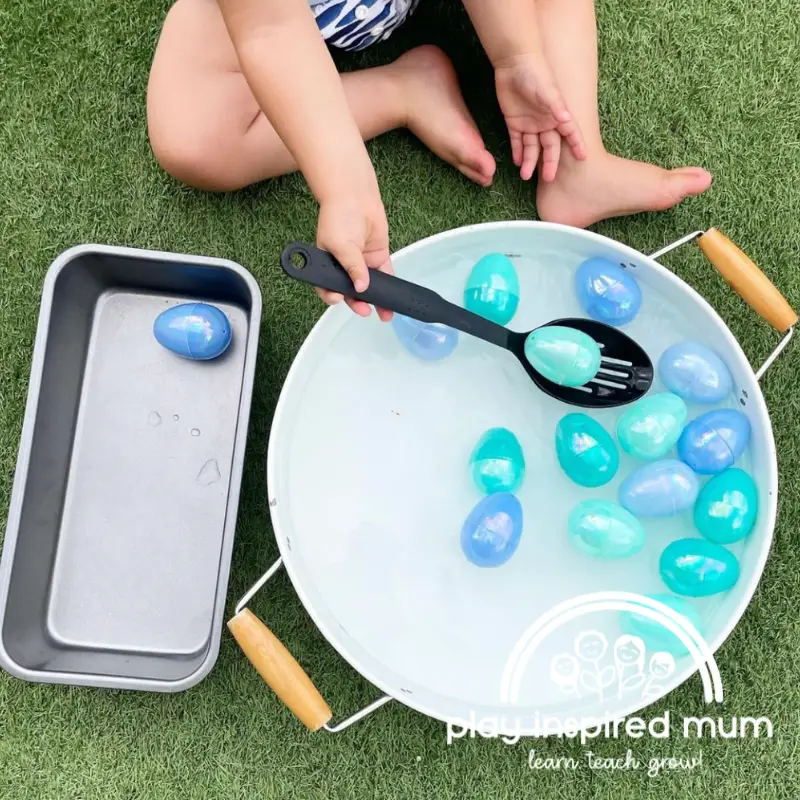
Step-by-Step Guide to the Egg Scoop Activity
I began this adventure by gathering all our materials:
- plastic Easter eggs,
- large tray
- loaf tin
- slotted spoon
- water
If you don’t have the exact materials on hand venture into your kitchen.
First stop, your plastics cupboard or pot and pans.
Find one big enough to hold the water and eggs and another for the eggs to be transferred into.
Next stop is your second draw down.
Kitchen spoons are great play resources.
These included everything from slotted spoons to ladles, perfect for little hands eager for sensory play.
Next, it was time for the main event.
You could almost see the wheels turning in my toddler’s mind as they approached the setup, a mixture of curiosity and excitement lighting their eyes.
They started with the slotted spoon, cautiously scooping out a plastic egg and transferring it to the bread tin.
The thrill of success was palpable, urging them to try again with a different tool.
Such a simple success bought so much joy over his little face.
As he explored, it became a lesson in cause and effect.
They discovered the joy of splashing water, the challenge of crossing the midline without spilling, and the subtle skill of hand-eye coordination—all facilitated by the humble plastic egg and water play.
And so, through play, meaningful learning blossomed in an afternoon of laughter and splashes.
Exploring and Learning
In their quest to scoop and transfer, toddlers embark on a rich sensory play adventure.
They will discover the intriguing outcomes of cause and effect, learning quickly how scooping up plastic Easter eggs filled with water leads to delightful splashes.
I found the anticipation in their eyes exhilarating as they watched water escape the eggs, a testament to their burgeoning understanding of cause and effect.
The movement of scooping and transferring not only entertains but also sharpens hand-eye coordination.
Their delight was palpable when the eggs cracked open, sending water everywhere.
This water play for toddlers, enhanced with plastic eggs and slotted spoons, served as an excellent tool for crossing the midline, a crucial developmental skill.
Through meaningful play, this water play for babies transformed into a learning conduit, weaving together sensory play for babies and sensory play for toddlers into one cohesive tapestry of exploration and growth.
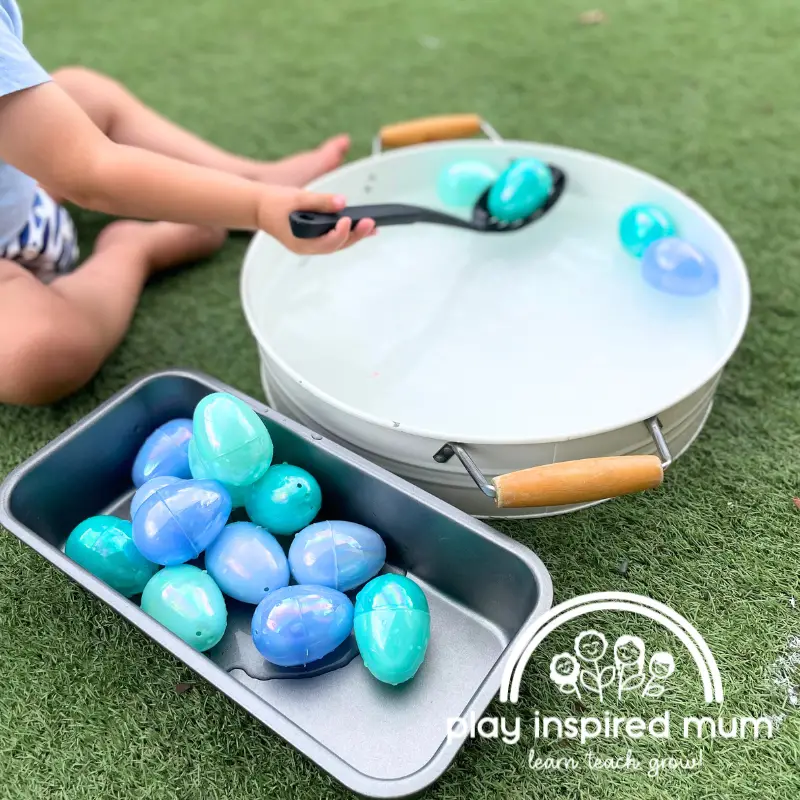
Wrapping Up the Fun
Through our playful journey, we dipped our toes and more into the world of scoop and transfer activities with water play for toddlers.
These sessions opened a gateway to a realm where learning through play transformed the mundane into the magical.
I witnessed firsthand how toddlers, armed with plastic eggs, scoopers, and a dose of curiosity, embarked on an adventure of sensory play that was both meaningful and delightful.
The splash of water, the clatter of plastic easter eggs, and the laughter that echoed signaled more than just fun; they were the sounds of growth, understanding, and the joy of discovery.
Water play for toddlers, and indeed babies, unfolded as a vibrant canvas for sensory exploration.
It was a haven where fine motor skills were honed with each scoop and transfer.
This activity, simple in setup, was monumental in impact. It fostered hand-eye coordination, taught the principles of cause and effect, and nurtured an early appreciation for the dynamics of water.
The crossing of the midline during this play contributed to their cognitive development, laying the groundwork for crucial skills they will build upon in the coming years.
As each day unfolded, I saw confidence bloom in the small faces of those who engaged in this sensory play for toddlers.
With slotted spoons in hand, they navigated the waters of their miniature worlds, undeterred by the challenges of transferring water-filled plastic Easter eggs from one container to another.
This is why I passionately encourage you to dive into the world of water play, sensory play, and meaningful play with your little learners.
Let’s fill their days with play ideas that spark joy, encourage creativity, and build a foundation for lifelong learning.
